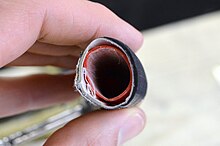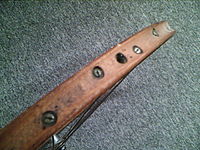Tubular tyre


A tubular tyre, referred to as a tub in Britain,[1] a sew-up in the US, a single in Australia[citation needed], or just a tubular is a bicycle tyre that is stitched closed around the inner tube to form a torus. The combination is then glued (sometimes with two-sided tape) onto a specially designed rim, referred to as a "sprint rim" in Britain,[2][3] and just a "tubular rim" in the US,[4] of a bicycle wheel.
The combination of a tubular tyre and its tubular rim is lighter than that of a clincher tyre and clincher rim, and will therefore always result in less rotating mass or a stronger construction.[5] Tubulars can also be used used over a wider range of tyre pressures from 1.7 to 14 bar (25 to 200 psi), compared to the typical 6-9 bar on a clincher tyre.
History

For amateur road cycle racing, clincher tyres largely replaced tubular tyres in the early 2000s, but saw a resurgence when carbon rims increased in popularity due to the carbon rim being better suited to the tubular design.[citation needed]
In the 2010s, tubular tyres were still commonly used for indoor track racing (where the closed track makes punctures from road debris less commonplace), professional road racing, road time trials, and cyclo-cross racing.[citation needed]
In 2009, a tubeless tubular with an integrated airtight liner instead of a separate inner tube was introduced.[6]
Weight considerations
The tubular tyre and rim combination has the potential to either be slightly lighter or stronger than more common clincher tyres.[5] While the clincher tyres and rims technology has caught up in recent years, the total weight of a tubular rim and tyre is still always lighter than its clincher equivalent.
Outside racing, the total lightness advantage is somewhat offset by the need to carry at least one entire spare tubular tyre (only a patch kit or inner tube are needed if using clincher tyres).
Yet the extra weight—and more importantly, rotational inertia—is off the wheel, and a tubular tyre therefore has the potential to accelerate more easily. Advances in tyre sealant have made carrying an extra tyre a bit outdated.
Safety
Puncture safety
An advantage of tubular tyres is that it is a "closed system" where the inner tube is enclosed within the outer tyre casing, meaning in the event of a flat that the air typically escapes far less quickly than with a clincher.[citation needed] For this reason tubulars are generally regarded[by whom?] as safer to ride than clinchers on fast mountain descents.
Controllability in the event of a puncture
A properly glued tubular tyre may be regarded as safer in the event of a puncture at high speeds because it is not as susceptible to roll off the rim, tubular and tubeless tyres in which punctured tyre more easily can roll off the rim and lead to loss of bike control, and a crash.[7]
Heating from rim brakes
Tubular tyres can be less safe with rim brakes on long descents because the heat generated by braking can cause the glue holding the tyre to the rim to fail.[8]
Additionally, excessive heat from rim brakes an cause the tyre pressure to increase so much that the tyre can explode,[9] but this problem also applies for clincher tyres used with rim brakes.
Tyre change
When a tubular tyre is worn out, it is easiest and most common to replace the entire tyre. If it punctures and is to be repaired, it requires more labour to repair than a clincher tyres (wired–on in Britain), as the tyre must be removed from the rim, opened up, patched, sewn back up, then finally glued back to the rim.
In emergency situations, for example in the event of a flat tyre on a bike ride, one can get home by cycling on a new tubular tyre that has not been glued, or with a previously-used one with glue that has not dried completely, but care must be taken to ride gently until home as the tyre will not be fully-affixed to the rim.
Tubular tyres may have less chance of a puncture when changing tyres compared to clincher tyres where the tube can easily get pinched and punctured.[1]
Tubular tyres are typically fitted with Presta valves.[1]
Gallery
-
Rims for tubular tyres, referred to as "sprint rims" in Britain
-
Wooden bicycle rim with tubular tyre and a Presta valve
-
Detail of wooden rim for tubular tires
See also
References
- ^ a b c Sheldon Brown. "Sheldon Brown's Glossary Tp-Z: Tub". Retrieved 2016-09-28.
- ^ St. Pierre, Roger (1978). The Book of the Bicycle. Tribune Books Press. pp. 24–26. ISBN 0-85674-016-0.
- ^ Sheldon Brown. "Sheldon Brown's Bicycle Glossary Sp-Ss: Sprint". Retrieved 2010-03-22.
British: a rim designed for tubular tyres.
- ^ "Tubular Tire Gluing". Park Tools. Retrieved 2010-03-24.
The tubular is then glued to a special rim, called a tubular rim.
- ^ a b Arthur S. Waltho (1964). Guide to Tubular Tyres, Including Sprint Rims.
- ^ "Bike Europe: Tufo Tubeless Road Racing Tyres". 2009-01-15. Retrieved 2016-12-10.
- ^ "Tubulars vs. Clinchers". Above Category. 2017-10-28. Retrieved 2023-06-18.
- ^ "Tour de France: Kelderman's crash due to melting tubular glue". Retrieved 2017-10-30.
- ^ "Technical FAQ: Hot tires and rims in Oman". Retrieved 2017-10-30.


